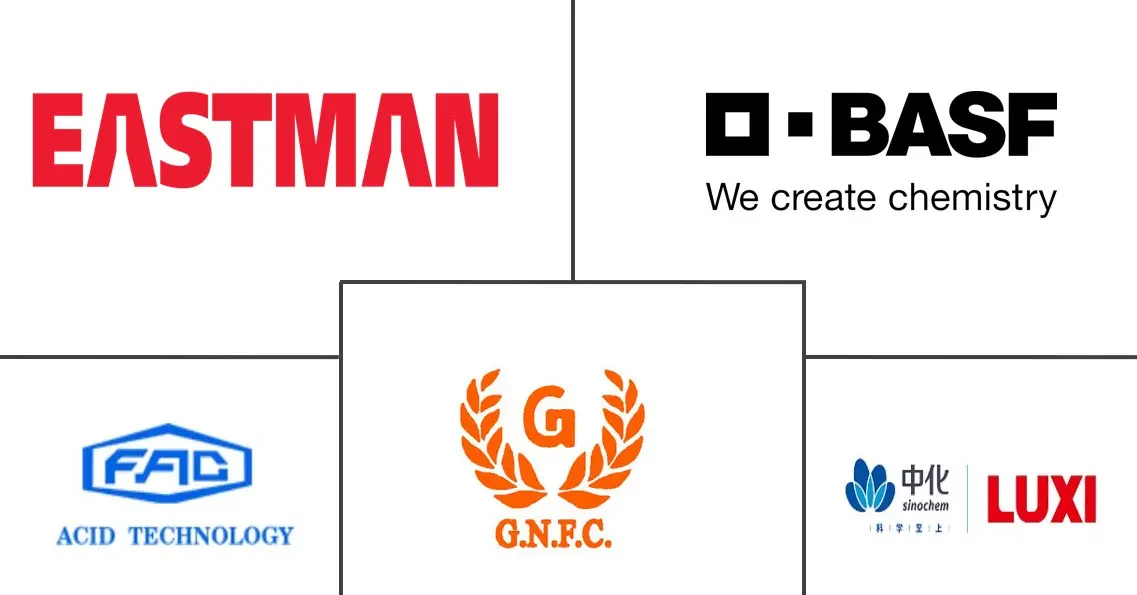Formic Acid Market Size and Share
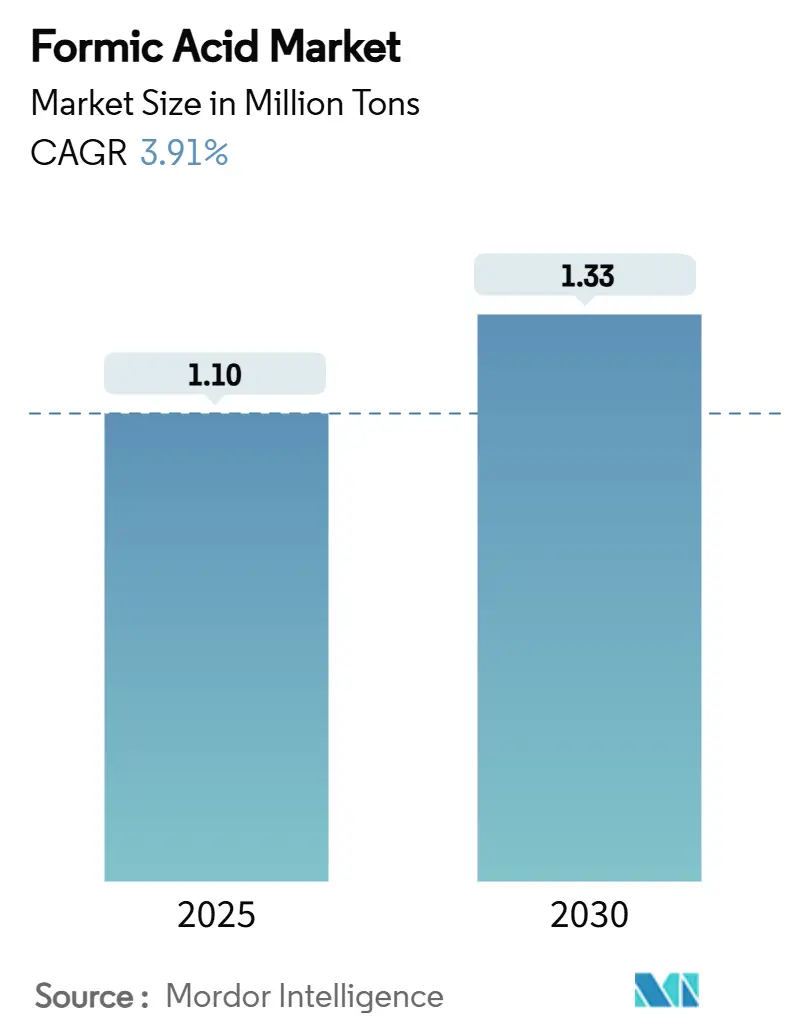
Formic Acid Market Analysis by Mordor Intelligence
The Formic Acid Market size is estimated at 1.10 Million tons in 2025, and is expected to reach 1.33 Million tons by 2030, at a CAGR of 3.91% during the forecast period (2025-2030). Rising demand for antibiotic-free animal feed, accelerating investment in bio-based production, and steady uptake across leather, rubber, and pharmaceutical applications underpin this growth path. Animal feed preservation already captures 37.04% of global consumption, and bio-based routes are expanding at 4.72% CAGR as producers seek lower-carbon footprints. Regional momentum is led by Asia-Pacific, where abundant manufacturing capacity and supportive policies are expected to secure a 4.61% regional CAGR through 2030. Process innovation—most notably electrochemical CO₂-to-formic acid conversion—could further reshape supply economics as pilot projects move toward commercial scale
Key Report Takeaways
- By application, animal feed & silage additives led with 37.04% of formic acid market share in 2024; the segment is projected to grow at 4.21% CAGR through 2030.
- By production route, methyl formate hydrolysis held 59.19% of the formic acid market size in 2024, while bio-based pathways are set to expand at a 4.72% CAGR.
- By end-use industry, agriculture commanded 39.19% of the formic acid market share in 2024; pharmaceuticals represent the fastest-growing end use at a 4.5% CAGR.
- By geography, Asia-Pacific dominated with 53.21% of the formic acid market in 2024 and is advancing at a 4.61% regional CAGR.
Global Formic Acid Market Trends and Insights
Driver Impact Analysis
| Driver | (~) % Impact on CAGR Forecast | Geographic Relevance | Impact Timeline |
|---|---|---|---|
| Growing demand for animal feed and silage additives | +1.2% | Europe & North America (highest); global | Medium term (2-4 years) |
| Substantial demand from leather and tanning industry | +0.8% | China & India | Medium term (2-4 years) |
| Increasing demand for rubber products | +0.7% | Southeast Asia | Short term (≤ 2 years) |
| Growing adoption in pharmaceutical industry | +0.6% | North America & Europe | Long term (≥ 5 years) |
| Growing Advancements in Bio-based Production | +0.5% | Europe and North America | Long term (≥5 yrs) |
| Source: Mordor Intelligence | |||
Growing Demand for Animal Feed and Silage Additives
Demand for antibiotic-free livestock production has positioned formic acid as a preferred preservative and antimicrobial. At 4 kg/ton in poultry diets, the acid can drive Salmonella counts to undetectable levels, safeguarding food safety and reinforcing regulatory compliance. The European Food Safety Authority allows inclusion rates up to 12,000 mg/kg for pigs and 10,000 mg/kg for poultry, providing legal certainty that accelerates adoption[1]European Food Safety Authority, “Formic Acid for All Animal Species,” efsa.europa.eu. These factors collectively lift feed-segment consumption above overall formic acid market growth.
Substantial Demand from Leather and Tanning Industry
Premium leather production relies on formic acid to adjust bath pH to 3.8–4.2, accelerating chrome fixation while lowering salt loads compared with mineral acids. Chinese and Indian tanneries, which supply a sizable portion of global hides, increasingly specify ≥ 85% purity, opening price-premium opportunities for suppliers able to guarantee consistency.
Increasing Demand for Rubber Products
Natural rubber processors prefer formic acid for precise coagulation, cutting sheet-drying times and enhancing tensile strength. BASF notes that 85% and 94% grades deliver the best cost-performance balance, supporting accelerated uptake across Malaysia, Thailand, and Indonesia.
Growing Adoption in Pharmaceutical Industry for Antibacterial Properties
Research teams are engineering formic-acid-derived hydrogels that speed diabetic wound healing by promoting tissue regeneration. The compound’s compatibility with numerous functional groups also makes it an essential intermediate in active pharmaceutical ingredient synthesis, pushing demand for pharmaceutical-grade material that commands higher margins.
Restraint Impact Analysis
| Restraint | (~) % Impact on CAGR Forecast | Geographic Relevance | Impact Timeline |
|---|---|---|---|
| Methanol feedstock price volatility | −0.9% | Global | Short term (≤ 2 years) |
| Risks related to corrosion and handling | −0.6% | Global | Medium term (2-4 years) |
| Rising Usage of Bio-propionic Acid as Alternative | -0.3% | Europe and North America | Long term (≥5 yrs) |
| Source: Mordor Intelligence | |||
Methanol Feedstock Price Volatility
Because methanol represents 60–70% of production costs in methyl formate hydrolysis, natural-gas-linked price swings compress margins and complicate long-term supply contracts. Producers are hedging by piloting CO₂ electro-reduction routes that could break feedstock dependence if renewable power prices keep falling.
Risks Related to Corrosion and Handling
Concentrations above 85% corrode carbon steel and require stainless-steel or polymer-lined equipment, elevating capital costs. OSHA exposure limits of 5 ppm further mandate strict ventilation and personal protective measures [2]National Institute for Occupational Safety and Health, “Formic Acid – NIOSH Pocket Guide to Chemical Hazards,” cdc.gov. Formulators such as Borregaard have responded with lignosulfonate-buffered blends that cut corrosivity while maintaining antimicrobial action, opening access for smaller feed mills.
Segment Analysis
Application: Feed Additives Drive Market Momentum
Animal feed & silage additives controlled 37.04% of global volume in 2024, giving the segment the largest slice of formic acid market size. Supported by regulatory curbs on antibiotic growth promoters, this share is projected to widen at a 4.21% CAGR. In poultry rations, inclusion rates of 4 kg/ton eliminate detectable Salmonella, boosting farmer confidence and retailer acceptance. Leather tanning remains the second-largest application, capitalizing on the acid’s pH control and chrome-penetration benefits, while textile mills value its dye-bath buffering capability. Pharmaceutical and specialty chemical uses are emerging, where high-purity requirements yield premium prices.
Growth prospects extend to natural rubber processing, which adopts formic acid for faster coagulation kinetics and higher aggregate tensile strength. Cleaning and descaling occupy a steady but smaller niche, leveraging the acid’s mineral-scale dissolving power at lower environmental impact than stronger inorganic acids. Safety-engineered formulations such as SoftAcid broaden access among smaller operations, suggesting incremental demand upside over the forecast period.
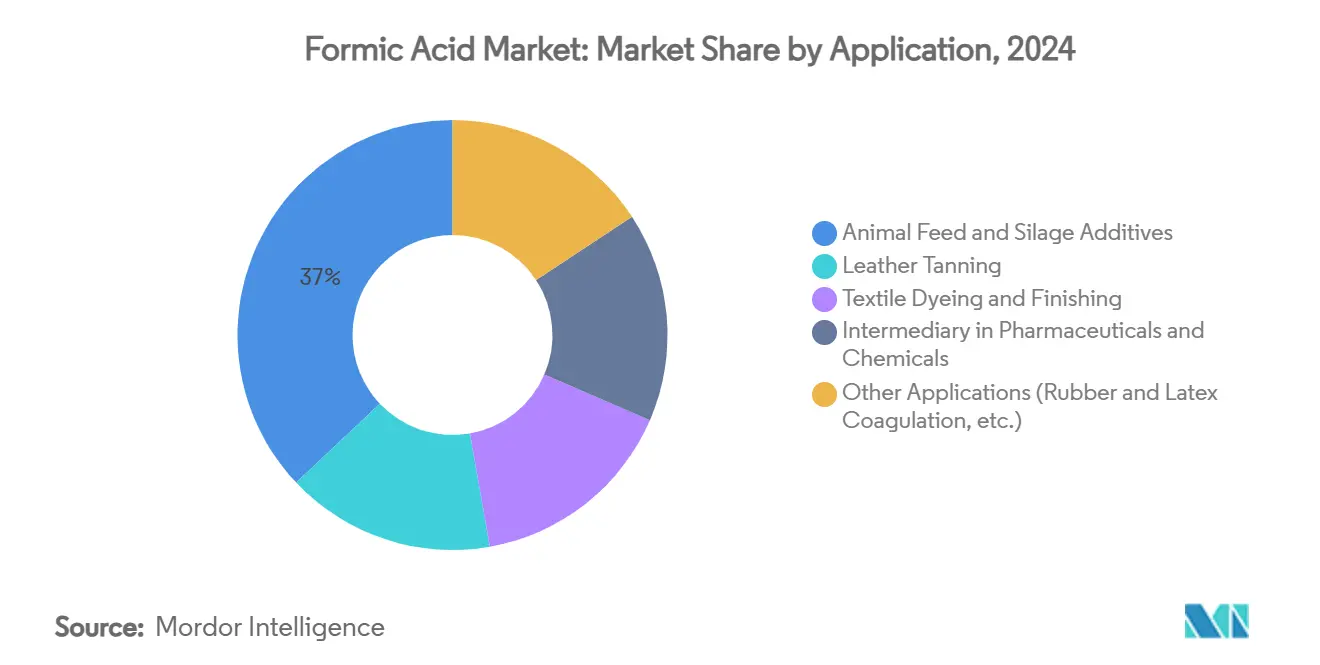
Note: Segment shares of all individual segments available upon report purchase
Production Method: Efficiency Drives Process Innovation
Methyl formate hydrolysis retained 59.19% share of the formic acid market in 2024, reflecting favorable scale economics and mature technology. Carbonylation remains the runner-up, while bio-based routes are rising rapidly at 4.72% CAGR as manufacturers aim to decouple from fossil inputs. The oxalic-acid route occupies a niche for ultra-high-purity output. Breakthroughs from the National Renewable Energy Laboratory have shown that a membrane-electrode assembly can convert CO₂ directly to concentrated formic acid at high Faradaic efficiency, laying groundwork for commercial roll-out if renewable power costs drop below 2.3 cents/kWh[3]National Renewable Energy Laboratory, “New Device Architecture Enables Streamlined Production of Formic Acid from CO₂ Using Renewable Electricity,” nrel.gov .
Over the next decade, capital deployment is expected to tilt toward low-carbon pathways, especially in Europe and North America where carbon-pricing regimes tighten. Producers investing early in CO₂-to-formic acid facilities can secure first-mover advantages in green-chemistry procurement channels, potentially reshaping regional competitive standings.
End-use Industry: Agricultural Applications Lead Growth
Agriculture represented 39.19% of 2024 demand and is set to expand at a 4.44% CAGR through 2030—greater than the overall formic acid market. Adoption is driven by livestock producers replacing antibiotics with organic acids to comply with tightening food-safety rules. Leather & footwear ranked second in volume; continued urbanization in Asia supports steady growth for this segment despite rising environmental scrutiny. Textile mills use the acid as a dye-bath pH adjuster, while chemicals & solvents consumers value its reactivity for producing esters and formates.
Pharmaceutical uses, though smaller in volume, deliver high margins thanks to stringent purity standards. Rubber manufacturers in Southeast Asia are boosting intake in line with rising natural-rubber output. Early exploration of formic acid as a hydrogen carrier for fuel-cell mobility could unlock fresh demand if infrastructure matures, bolstering long-term upside.
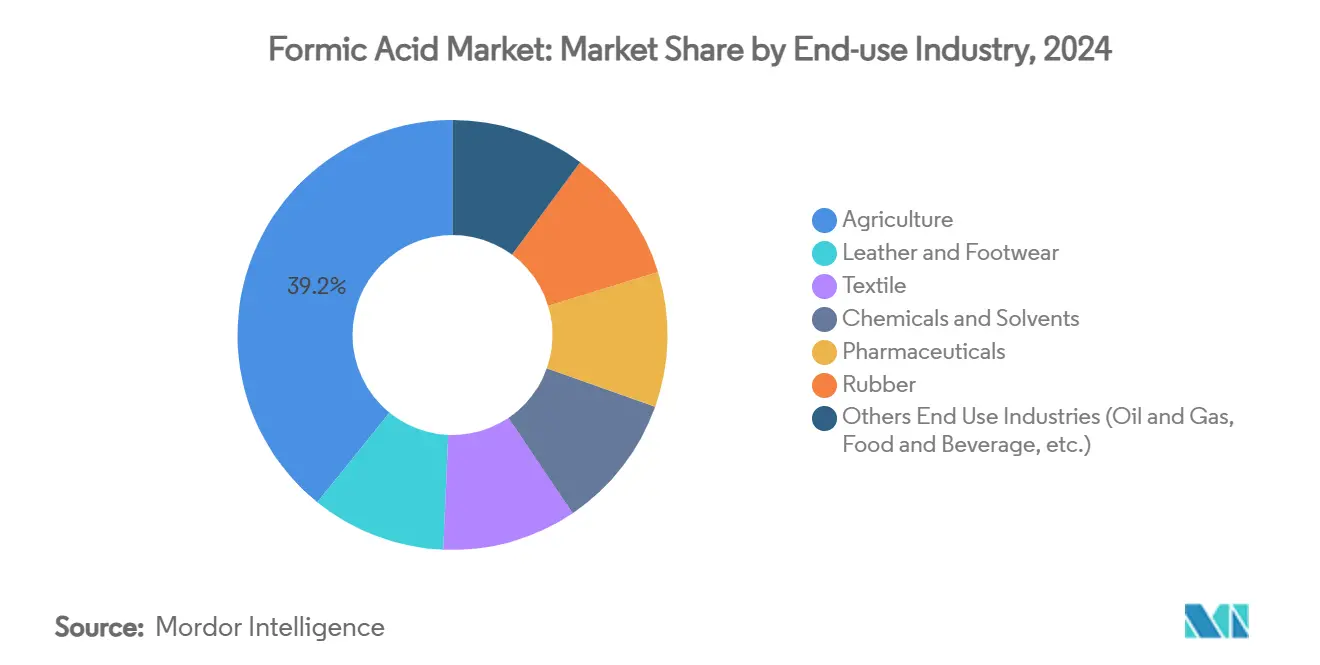
Note: Segment shares of all individual segments available upon report purchase
Geography Analysis
Formic Acid Market in Asia-Pacific
Asia-Pacific held 53.21% of global consumption in 2024, giving the region the largest slice of formic acid market share. China dominates regional supply, leveraging integrated methanol and downstream chemical complexes to ensure cost competitiveness. India’s producers, supported by export incentives and growing domestic leather output, are building new plants that lift regional self-sufficiency. Japan and South Korea source high-purity material for electronics and pharmaceutical synthesis, while Indonesia drives incremental growth through rubber-sector uptake.
North America is the second-largest region, propelled by a vast animal-protein sector and government funding for CO₂-utilization R&D. The United States leads pilot deployment of electrochemical production units, eyeing commercial scale by decade-end. Canada’s demand is tied mainly to grain and livestock production, whereas Mexico sees rising leather and textile usage.
Europe combines strict feed and chemical regulations with aggressive decarbonization targets, spurring investment in bio-based processes. EU anti-dumping measures on imported chemicals intensify competition and encourage local capacity expansion. South America’s growth centers on Brazil’s expanding livestock sector, while the Middle East benefits from diversification agendas that encourage specialty-chemical investments. Cross-regional trade flows will likely stay fluid as Asia grows exports and western regions pivot to low-carbon supply chains.
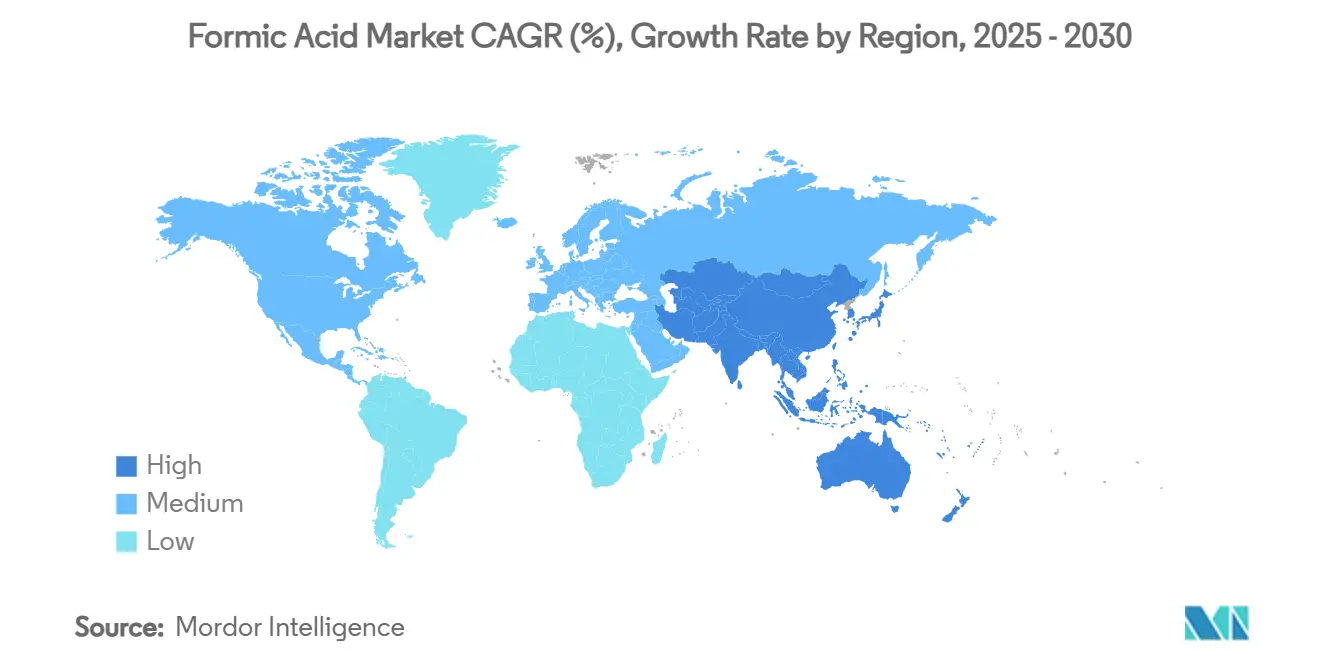
Competitive Landscape
The formic acid market is consolidated, with BASF leading through integrated plants in Germany, China, and the U.S., mitigating feedstock volatility. Chinese firms like LUXI Group and Shandong Rongyue Chemical are expanding with units exceeding 100,000 tons/year, enhancing regional self-reliance and pressuring prices. Strategic moves include forward integration into feed-acid blends, renewable power agreements, and joint ventures targeting pharmaceutical-grade volumes. Start-ups, supported by public R&D grants, are scaling electrochemical devices to reduce carbon intensity and costs. BASF’s industrial heat pump at Ludwigshafen will produce CO₂-free steam, emphasizing sustainability. With North American capacity retiring and Asian self-sufficiency rising, competition is shifting to quality and carbon footprint. Suppliers meeting cradle-to-gate emissions benchmarks can secure premium contracts in feed, pharma, and energy storage markets.
Formic Acid Industry Leaders
-
Eastman Chemical Company
-
Shandong Acid Technology Co. Ltd.
-
BASF
-
Luxi Chemical Group Co.,Ltd.
-
Gujarat Narmada Valley Fertilizers and Chemicals Ltd
- *Disclaimer: Major Players sorted in no particular order
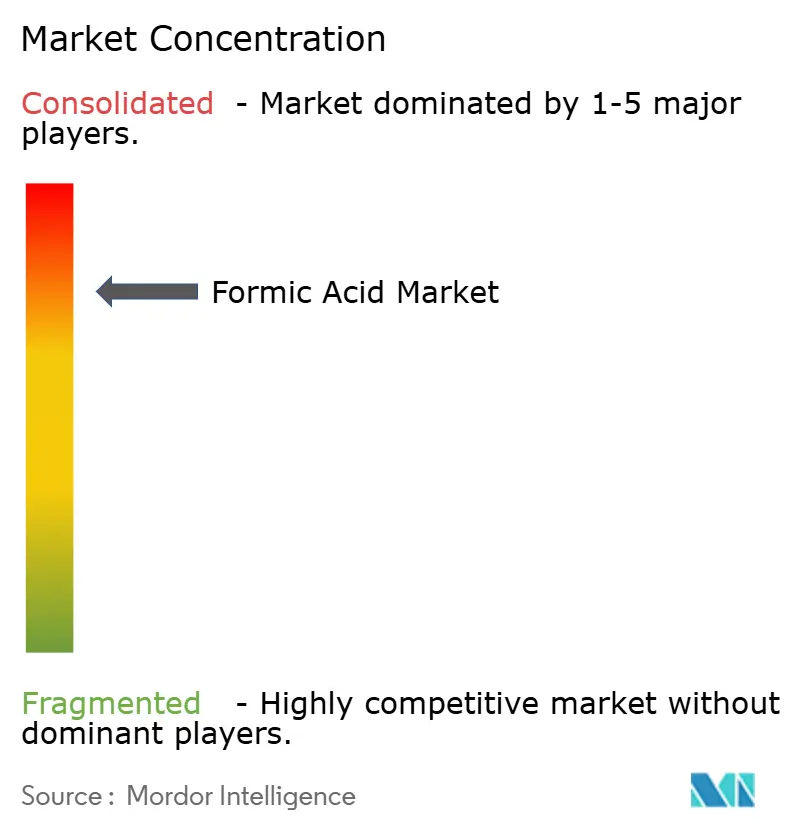
Recent Industry Developments
- June 2025: BASF introduced its formic acid (FA) on the eAuction digital platform in China, enabling customers to bid and track auctions in real-time. The platform enhances procurement efficiency, provides market insights, and aligns with BASF’s goal of being a preferred partner for sustainable intermediates.
- October 2024: BASF secured funding from Germany's Federal Ministry for Economic Affairs and Climate Action to build the world's most powerful industrial heat pump, capable of cutting greenhouse gas emissions by up to 98% in its formic acid plant. The plant is set to begin operations in 2027.
Global Formic Acid Market Report Scope
Animal feed and silage additive manufacturers use formic acid as an additive in solid or liquid forms, which are both considered safe for animal health. The formic acid market is segmented by Application and Geography. By Application, the product is segmented into animal feed and silage additives, leather tanning, textile dyeing, finishing, an intermediary in pharmaceuticals, and other applications. The report also covers the market size and forecasts for the formic acid market in 15 countries across major regions. For each segment, the market sizing and forecasts have been done based on volume (Kilotons).
| Animal Feed and Silage Additives |
| Leather Tanning |
| Textile Dyeing and Finishing |
| Intermediary in Pharmaceuticals and Chemicals |
| Other Applications (Rubber and Latex Coagulation, Cleaning and Descaling Agents, etc.) |
| Methyl Formate Hydrolysis |
| Carbonylation Technology |
| Other Production Methods (Oxalic-acid Route, Fermentation/Bio-based Route) |
| Agriculture |
| Leather and Footwear |
| Textile |
| Chemicals and Solvents |
| Pharmaceuticals |
| Rubber |
| Others End User Industries (Oil and Gas, Food and Beverage, etc.) |
| Asia-Pacific | China |
| India | |
| Japan | |
| South Korea | |
| Rest of Asia-Pacific | |
| North America | United States |
| Canada | |
| Mexico | |
| Europe | Germany |
| United Kingdom | |
| France | |
| Italy | |
| Rest of Europe | |
| South America | Brazil |
| Argentina | |
| Rest of South America | |
| Middle East and Africa | Saudi Arabia |
| South Africa | |
| Rest of Middle-East and Africa |
| By Application | Animal Feed and Silage Additives | |
| Leather Tanning | ||
| Textile Dyeing and Finishing | ||
| Intermediary in Pharmaceuticals and Chemicals | ||
| Other Applications (Rubber and Latex Coagulation, Cleaning and Descaling Agents, etc.) | ||
| By Production Method | Methyl Formate Hydrolysis | |
| Carbonylation Technology | ||
| Other Production Methods (Oxalic-acid Route, Fermentation/Bio-based Route) | ||
| By End-use Industry | Agriculture | |
| Leather and Footwear | ||
| Textile | ||
| Chemicals and Solvents | ||
| Pharmaceuticals | ||
| Rubber | ||
| Others End User Industries (Oil and Gas, Food and Beverage, etc.) | ||
| By Geography | Asia-Pacific | China |
| India | ||
| Japan | ||
| South Korea | ||
| Rest of Asia-Pacific | ||
| North America | United States | |
| Canada | ||
| Mexico | ||
| Europe | Germany | |
| United Kingdom | ||
| France | ||
| Italy | ||
| Rest of Europe | ||
| South America | Brazil | |
| Argentina | ||
| Rest of South America | ||
| Middle East and Africa | Saudi Arabia | |
| South Africa | ||
| Rest of Middle-East and Africa | ||
Key Questions Answered in the Report
What is the current Formic Acid Market size?
The formic acid market stands at 1.10 million tons in 2025 and is projected to reach 1.33 million tons by 2030 at a 3.91% CAGR.
Which application segment leads global demand?
Animal feed & silage additives dominate, holding 37.04% of formic acid market share in 2024 and growing at 4.21% CAGR through 2030.
Why is Asia-Pacific the largest regional market?
Asia-Pacific benefits from extensive manufacturing capacity, especially in China and India, giving the region 53.21% of global volume and the fastest regional CAGR of 4.61%.
How are producers addressing methanol price volatility?
Leading companies are piloting CO₂-to-formic acid electrochemical routes and investing in renewable-power-driven heat-integration projects to decouple costs from fossil feedstocks.
What makes formic acid attractive to the pharmaceutical sector?
Pharmaceutical-grade formic acid offers high purity and versatile reactivity, enabling synthesis of complex molecules and advanced hydrogels that accelerate wound healing.
Page last updated on:
